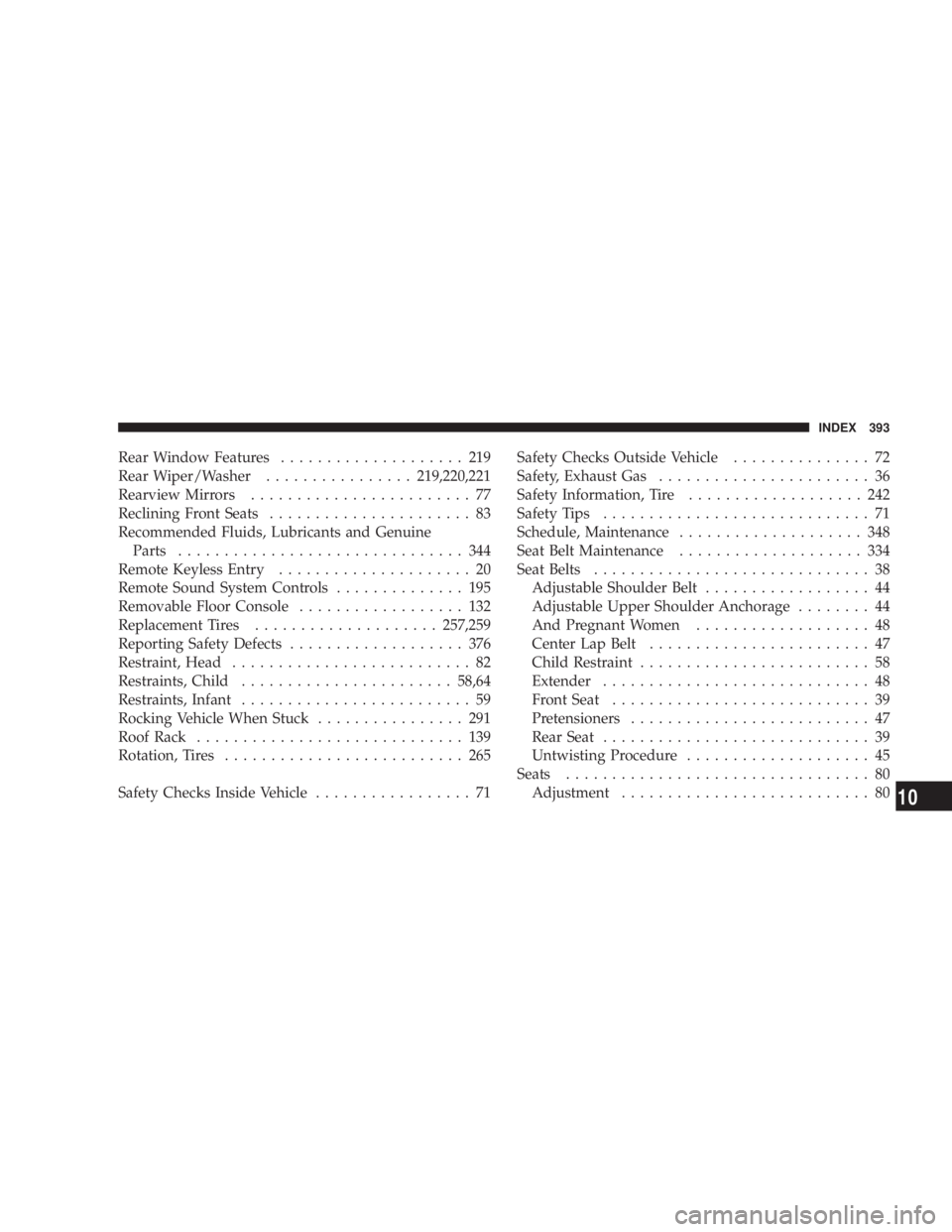Page 76 of 397

N Erasing Homelink Buttons ...............124
N Reprogramming a Single Homelink Button . . . 124
N Security ............................124
m Power Sunroof Ð If Equipped .............125
N Express Open Feature ..................126
N Wind Buffeting .......................127
N Sunroof Maintenance ...................127
m Electrical Power Outlets Ð If Equipped .......127
N Electrical Outlet Use With Engine Off .......129
m Convenience Tray Drawer And Cup Holders . . . 129
N Instrument Panel Cup Holders ............129 N Convenience Tray And Optional Smoker's
Package Kit .........................130
N Rear Cupholders ......................130
m Storage ..............................132
N Front Seat Storage Bin Ð If Equipped .......132
N Removable Floor Console Ð If Equipped ....132
N Rear Compartment Storage Bins ...........135
N Cargo Area Storage ....................135
N Cargo Organizer Ð If Equipped ...........136
m Roof Luggage Rack Ð If Equipped ..........139
m Load Leveling System ...................14176 UNDERSTANDING THE FEATURES OF YOUR VEHICLE
Page 139 of 397
Cargo Organizer removal
Unscrew the two plastic fasteners located on the floor of
the rear of the cargo area and remove the cargo organizer
from the vehicle.
NOTE: The cargo organizer must be removed to take
out the third row seat. ROOF LUGGAGE RACK Ð IF EQUIPPED
The crossbars and siderails are designed to carry the
weight on vehicles equipped with a luggage rack. The
load must not exceed 150 lbs (68 kg), and should be
uniformly distributed over the luggage rack crossbars.
Distribute cargo weight evenly on the roof rack crossbars.
The roof rack does not increase the total load carrying UNDERSTANDING THE FEATURES OF YOUR VEHICLE 139
3
Page 141 of 397

CAUTION!² To avoid damage to the roof rack and vehicle, do
not exceed the maximum roof rack load capacity
of 150 lbs (68 kg). Always distribute heavy loads
as evenly as possible and secure the load appro-
priately.
² Long loads which extend over the windshield,
such as wood panels or surfboards, or loads with
large frontal area should be secured to both the
front and rear of the vehicle.
² Travel at reduced speeds and turn corners care-
fully when carrying large or heavy loads on the
roof rack. Wind forces, due to natural causes or
nearby truck traffic, can add sudden upward
loads. This is especially true on large flat loads
and may result in damage to the cargo or your
vehicle. WARNING!Cargo must be securely tied before driving your
vehicle. Improperly secured loads can fly off the
vehicle, particularly at high speeds, resulting in
personal injury or property damage. Follow the Roof
Rack Cautions when carrying cargo on your roof
rack.
LOAD LEVELING SYSTEM
The automatic load leveling system will provide a level
riding vehicle under most passenger and cargo loading
conditions.
A hydraulic pump contained within the shock absorbers
raises the rear of the vehicle to the correct height. It takes
approximately 1 mile (1.6 km) of driving for the leveling
to complete depending on road surface conditions. UNDERSTANDING THE FEATURES OF YOUR VEHICLE 141
3
Page 393 of 397

Rear Window Features .................... 219
Rear Wiper/Washer ................ 219,220,221
Rearview Mirrors ........................ 77
Reclining Front Seats ...................... 83
Recommended Fluids, Lubricants and Genuine
Parts ............................... 344
Remote Keyless Entry ..................... 20
Remote Sound System Controls .............. 195
Removable Floor Console .................. 132
Replacement Tires .................... 257,259
Reporting Safety Defects ................... 376
Restraint, Head .......................... 82
Restraints, Child ....................... 58,64
Restraints, Infant ......................... 59
Rocking Vehicle When Stuck ................ 291
Roof Rack ............................. 139
Rotation, Tires .......................... 265
Safety Checks Inside Vehicle ................. 71 Safety Checks Outside Vehicle ............... 72
Safety, Exhaust Gas ....................... 36
Safety Information, Tire ................... 242
Safety Tips ............................. 71
Schedule, Maintenance .................... 348
Seat Belt Maintenance .................... 334
Seat Belts .............................. 38
Adjustable Shoulder Belt .................. 44
Adjustable Upper Shoulder Anchorage ........ 44
And Pregnant Women ................... 48
Center Lap Belt ........................ 47
Child Restraint ......................... 58
Extender ............................. 48
Front Seat ............................ 39
Pretensioners .......................... 47
Rear Seat ............................. 39
Untwisting Procedure .................... 45
Seats ................................. 80
Adjustment ........................... 80 INDEX 393
10